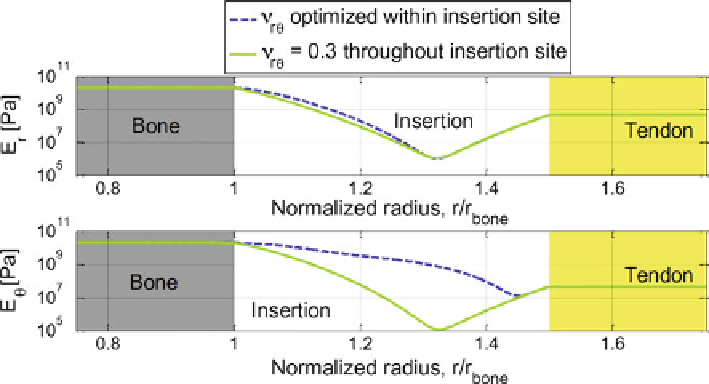Biomedical Engineering Reference
In-Depth Information
Fig. 11.2
The distribution of material properties for minimization of radial stress concentration
factor contains a biomimetic compliant band between tendon and bone (reproduced, with permis-
sion, from ref. [
24
])
tensile strain in human patellar tendon-to-bone insertions compared to the tendon
midsubstance [
26
]. Micro-compression experiments in the ACL insertion and
meniscal attachments demonstrated that regions of uncalcified cartilage had lower
compressive moduli than calcified regions [
27
-
29
]. A recent optimization study has
provided some rationale for a compliant region between tendon and bone, a
seemingly illogical interfacial system [
24
]. Through numerical optimization of a
mathematical model of an insertion site, it was shown that stress concentrations can
be reduced by a biomimetic grading of material properties (i.e., a compliant zone
between tendon and bone) (Fig.
11.2
).
The growth plate hypertrophic zone contains similar structural, compositional,
and morphological gradients to the tendon-to-bone insertion. These gradients also
contribute to variations in mechanical behavior that likely influence the tissue
response to mechanical loading. In rat growth plates, higher compressive strains
were detected in the hypertrophic region compared to the resting/proliferative region
[
30
,
31
]. The resting zone is also stiffer than the combined proliferative and
hypertrophic zones [
32
,
33
]. This result is consistent with the more compliant region
detected at the tendon- and ligament-to-bone interfaces.
The presence of a gradient in mineral content at the insertion also serves to
modulate the mechanical behavior of the tissue. Partially mineralized collagen
fibers result in a stiffness increase only for mineral concentrations above a “perco-
lation threshold” that corresponds to the formation of a continuous mineral net-
work. Modeling results demonstrate that an effective mechanical attachment is
created by combining the effects of a gradual increase in mineral content with
variations in collagen organization [
34
].

Search WWH ::

Custom Search